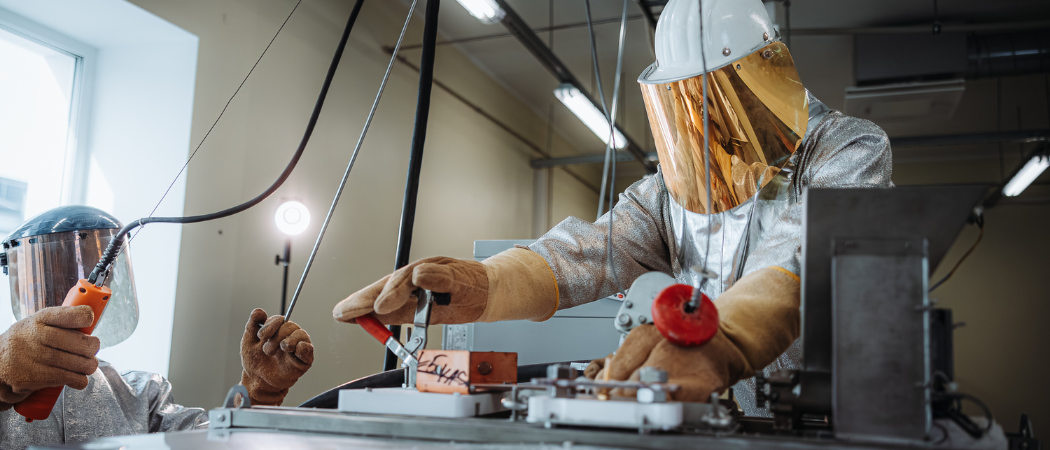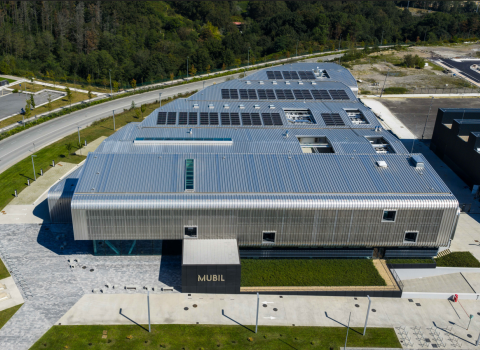Early and later stage start-ups will benefit from Estonia’s approach to building venture capital for green technologies

UP Catalyst, one of the start-ups supported by the SmartCap Green Fund, is scaling up to produce tonnes of graphite from carbon dioxide. Photo: UP Catalyst
Estonia is using €100 million from the NextGenerationEU recovery fund to bolster venture capital for green technology start-ups and scale-ups. After initially offering direct investment to early-stage companies, the SmartCap Green Fund established with the EU money is now providing anchor investments in two specialist green tech VC funds, and extending its direct investment focus to take in companies ready to scale-up.
The NextGenerationEU recovery fund was established in the wake of the COVID pandemic to build resilience in the European economy and hasten its green and digital transitions. Estonia chose to use some of this money to address a perceived weakness in the local venture capital market.
“Most of the Estonian VC ecosystem comes from a software background, so green tech start-ups, especially capital-intensive hardware start-ups, do not attract much VC interest,” said Robert Martin, an investment manager with the Green Fund.
Even so, the Estonian green technology sector is growing, driven by EU Green Deal policies. Kädi Ristkok, chief executive of the Estonian Cleantech Association said investment grew from around €50 million in 2020 to €140 million in 2021 and €260 million in 2023.
“The sector in Estonia is mostly younger companies, but little by little scale-ups are starting to appear,” she said. This covers most kinds of cleantech company, but scale-ups tend to be in the energy sector.
The weakness identified in the VC market for green tech affects both early-stage start-ups and those seeking to scale-up and internationalise. The Green Fund, established in 2022 by state-owned fund management company SmartCap, is intended to operate on both fronts.
SmartCap’s main role is to act as a fund of funds, using public money to attract in private investment, and this was also the approach intended for the Green Fund. But it was also clear that this would not happen over night.
“It takes one to two years to bring on a new VC fund with first-time fund managers, and we wanted the green tech start-ups to have access to this capital much earlier,” Martin said. “So SmartCap decided to make direct investments, before the new VC funds became active.”
The definition of green tech here is broad, covering sectors including energy, agriculture, food, transport and logistics, the materials and chemicals industries, and the environment in general. Within this, the Green Fund set out to support start-ups established and operating in Estonia, with high growth potential, and for preference not working on software applications.
Direct support
The Green Fund made six investments in early-stage start-ups during 2023. The most recent was in UP Catalyst, which has developed a technology that produces carbon materials from carbon dioxide emissions. Its aim is to offer European battery manufacturers a sustainable source of graphite, and an alternative to sourcing raw materials from China.
The Green Fund joined a €4 million seed round led by Berlin-based climate tech VC fund Extantia, its first investment in Estonia. Previous investors, Sunly, Little Green Fund, Scottish Baltic Invest and UniTartu Ventures also followed on.
Even at this early stage, the company was looking for an international funding round. “Our key customers are working on a global scale, so it was important that our funding should also be international,” said Rait Maasikas, the company’s chief financial officer. Having the Green Fund on board helped achieve that.
The company will use the funding to build an industrial pilot reactor capable of processing 100 tonnes of carbon dioxide annually, producing 27 tonnes of carbon materials.
Having a vote of confidence from an Estonian fund also helped Bisly build its €3.6 million seed round, according to its chief financial officer Kristjan Kõrgmaa. “The Green Fund said ‘Bisly looks good, it looks interesting’, and based on that soft commitment it was much easier to persuade our international VC investor to invest in us. It was reassured that we knew what we were doing.”
Founded in 2018, Bisly builds intelligent building systems that control functions such as heating, lighting, ventilation and security for commercial and residential properties. Providing both software and hardware led to investor hesitancy. “There is definitely a reluctance to look at the hardware side of things, but that is not just the case in Estonia,” Kõrgmaa said. “Many investors will say that they only do software.”
In the end, Bisly succeeded in building a highly international round, led by Belgian smart building tech fund Aconterra, with support from Second Century Ventures in the US, REACH UK, the SmartCap Green Fund and Pinorena Capital from Estonia, along with several angel investors. This international profile matches the purpose of the round, which was to support further expansion in the European market, notably in the UK and Germany.
The other companies receiving direct investment from the Green Fund were agriculture start-ups eAgronom and Paul-Tech; electric cargo bike company Vok Bikes; and Cuploop, which is developing technology to recycle reusable packaging.
New VC funds
At the same time as making these direct investments, SmartCap set out to find two private fund managers that would establish green tech investment funds, offering each a cornerstone investment of €20 million. The first of these funds, 2C Ventures, launched in January, with a second fund expected to follow later in 2024.
2C Ventures aims to build a €50 million fund for early-stage companies working on climate change mitigation, for example in renewable energy, waste reduction, water management, and the circular economy. Initial investment per company will range from €250,000 to €1 million, with follow-on investment an option. While Estonian companies come first, it can also look further a field in the Nordic and Baltic countries.
The SmartCap Green Fund can continue to invest directly in early-stage start-ups, but in practice this will be the exception rather than the rule. “It would be counter-intuitive for us to compete with 2C Ventures and the other fund,” Martin said. “And while we are happy to co-invest with them, we don’t want our portfolios to completely overlap, or to become the sole investors in all of the green tech companies at this stage.”
There is also a feeling that the ecosystem is responding well to the new funds. “What we are seeing, especially with 2C Ventures now on the market, is that the smaller rounds are being covered without our intervention,” Martin said. “So a €500,000 round will get funded, if it’s a decent opportunity.”
Part of that response is down to Estonia’s angel investors. “The angel investor network here is very active and quite wealthy, so for smaller rounds companies now have different options to choose from,” said Mattias Karu, a Green Fund investment manager.
Rait Maasikas at UP Catalyst agrees that the situation is improving, but thinks more could still be done. “The green tech area is getting more attention, which is a good thing, and more funds dedicated to green tech are available, but the opportunities could always be better,” he said.
The story is different when it comes to scaling up. “If a company is putting together a €5 million round, for example, they could probably get €2 million from private investors, but then there is a gap,” Martin said. “They may not be ready to attract foreign investors, but the smaller VCs in Estonia are not able to put this amount of money together by themselves.”
Kõrgmaa also sees a gap in scale-up investment. “Finding investors here who are doing tickets up to €100,000 is fairly straightforward, but finding investors willing to do tickets of €1 million is quite difficult,” he said.
Given this, the Green Fund will step in, expanding the scope of its direct investments to take in later stages of company development. The size of investment will also change, from the €250,000 to €2.5 million range set in its first year, to €500,000 to €5 million going forward. In all, the fund has €20 million to spend on direct investments.
Otherwise, the investment terms remain unchanged: private money must account for at least half of each round, and at least 30% must be new private capital for the company.
This does not exclude the Green Fund from following up its earlier direct investments. “We are currently seeing some of our portfolio companies putting together new rounds, and we are able to participate,” Martin said.
Now that it can invest in later rounds with bigger ticket sizes, the Green Fund hopes to attract more foreign investors to Estonia. In particular, the country needs foreign VCs to lead investment rounds.
“We are always looking for lead investors for our rounds,” said Karu. “The problem is that we only have a limited number of VCs in Estonia, and most foreign funds don’t yet know the opportunity we have to leverage a lead investor’s ticket.”
This development in SmartCap’s approach makes sense to Ristkok. “Starting from series B is where we really struggle to find investors, and we need to attract more foreign growth investors,” she said. “So, it seems logical that SmartCap should be the public risk-taker to initiate private investors into this sector.”
Broadening minds
The one-off €100 million from the EU recovery fund will support the Green Fund until 2026. After this, there are currently no plans for a second injection of capital. But if the fund succeeds in broadening the minds of local investors and bringing in more international heavyweights, it will have done its job. “The more that happens, the less we will need a dedicated Green Fund,” said Karu.
Even so, Ristkok would like to see the Green Fund have a bit more road than the €20 million set aside for direct investments. “It’s a good sum to start with, but it shouldn’t be the final amount,” she said. And the closer the fund gets to its €5 million maximum ticket size, the fewer investments it can make.
“We have many more cleantechs that are looking for this level of investment, so it would be good to have this resource in the future as well,” she said. “Estonia is still building its international cleantech brand, and this will really help attract attention.”
Having an international reputation in digital technologies has already helped boost Estonia’s start-up ecosystem, and the same could be done for green tech. “As a small country, its important that others know that you are in this game and serious about it,” she said.
Elsewhere in the Ecosystem…
- Three start-ups from central and eastern Europe made the cut for the third round of the New European Bauhaus accelerator programme. They are WasteLocker from Estonia, which has developed an internet-of-bins system to generate data for better waste management; SpaceCrop from Hungary, which supports farmers with satellite data and artificial intelligence; and Bluana from Romania, which is developing plant-based seafood alternatives.
- Estonian green hydrogen start-up Stargate Hydrogen raised €42 million to scale-up development of its ceramic-based electrolysers, an alternative to technologies using rare precious metals. This includes a seed equity round, led by Tallinn-based UG Investments, and grant financing through the EU’s Important Project of Common European Interest framework for hydrogen technologies.
- Estonian start-up 10Lines has secured €1.5 million to further develop its AI-driven road marking robots. The company, founded in 2019, will use the additional capital to expand its engineering team and strengthen its market presence in the US. The investment round was led jointly by Tera Ventures and Karista.





 A unique international forum for public research organisations and companies to connect their external engagement with strategic interests around their R&D system.
A unique international forum for public research organisations and companies to connect their external engagement with strategic interests around their R&D system.